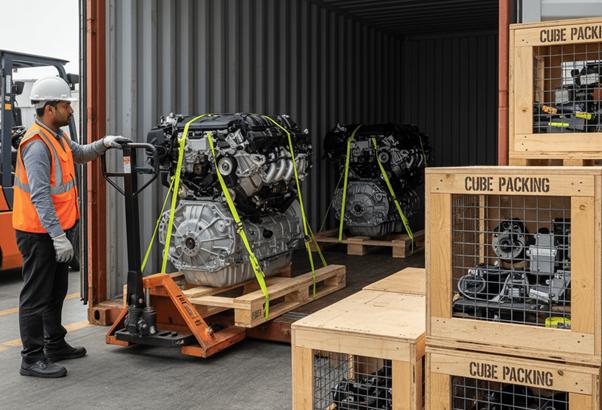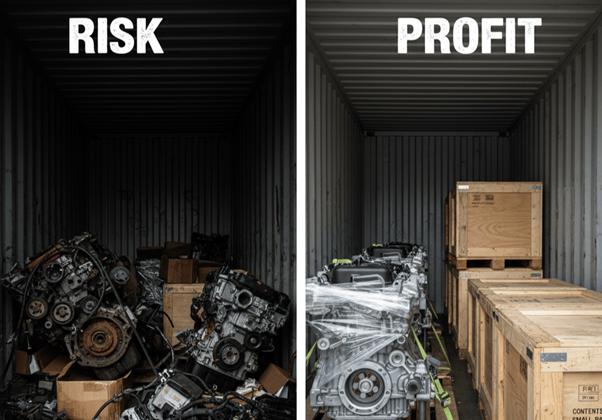
For a long time, the US has been the main source of used OEM auto parts for the whole world. Small garages to large wholesalers in areas like the Middle East, Africa, and Asia all depend on the US salvage market to get the best quality and low mileage parts from ‘total loss’ cars. Although it is a very profitable business, the real cost of transporting broken down car parts from the USA usually is way up there as compared to the price of the engine. Among the hidden costs are damaged stock, customs fees coming up that were not anticipated and total confusion when the container gets to your warehouse. A large number of importers unwittingly lose a lot of money because they consider dismantling and shipping as routine operations instead of vital components of their long-term supply strategy.
The errors that international buyers often commit will be pointed out in this plain guide which consists of five parts. Knowing about and correcting these errors will turn your imported Carkit (a completely dismantled vehicle) from being a financial risk to your business into a reliable, profitable and highly predictable product.
A skilled partner is a must for the success in this area. For over a decade now, USG Shipping has devoted itself to eliminating these risks for overseas buyers, thereby making the importation process secure and efficient.

The 5 Costly Importing Mistakes (and How to Avoid Them)
Mistakes often made like these seem at first to bring some savings but, in reality, they expose your business to great, unnecessary risks that can end up costing you the whole profit you made.
Mistake 1: Using the “Cheap Cut” Method and Ignoring Shipping Laws
Apart from the Halfcut method, which is also called the Nosecut, many buyers like using such methods since they enable squeezing the maximum number of vehicle units into a single container. This looks to be a means of lowering the freight cost per unit but, at the same time, it causes a whole legal headache. The danger here is the non-compliance because a lot of countries are very strict concerning the import of cut vehicle bodies. A poor or non-compliant cut can result in your shipment getting stuck at the port indefinitely, forced to be re-exported, or even confiscated by the authorities.
The costs here are—fines, storage (demurrage), and lost goods—far greater than any initial saving on the destruction fee. The smarter choice is to opt for Full Dismantling (The Carkit Method). When the vehicle chassis is completely seeping from all other parts, your cargo gets legally classified as “Auto Parts Inventory,” not a “Cut Vehicle.” This instantly wipes out the compliance risk and guarantees you to get the entire legal and financial worth from every part.
Mistake 2: Ignoring the High Cost of Parts Damaged During Transit
When you ship a container of dismantled parts in bulk, you are risking it all. A container that was not packed properly exposes little and, at the same time, very expensive parts to the danger of being crushed or bent. These parts include sensors, wiring harnesses, the best interior finish, and Electronic Control Units (ECUs) plus repairs of the corresponding control units. Buyers very often lose even up to 20% of their inventory which consists of small and expensive items by this method. In some instances, the very expensive single wiring harness that was damaged in a modern automobile may cost more than the total cost of dismantling the whole vehicle through the normal process when shipping alone is considered.
To avoid this, you should insist on the “Cube Packing” method. This professional technique not only employs custom wooden boxes but also uses very strong restraints. Engineers and transmissions are securely bolted to the pallets and all small, fragile components are cushioned and placed in the designated, protected compartments. This guarantees almost zero damage rate so you receive the exact and organized inventory for which you have paid.

Mistake 3: Taking a Chance on Engines That Haven’t Been Tested
In an import, engines and transmissions are typically the most valuable parts. If you find one engine with damaged internals, it means that the investment in that particular vehicle lot has been completely wasted. The danger in this situation is depending solely on the very few and vague notes from the US salvage auction (like “runs” or “starts”). Those notes are never a warranty and do not guarantee that the part will function without problems after the stress of international shipping dismantled auto parts from the USA.
The clever way to deal with this situation is to demand a partner who carries out Functional Testing before any critical powertrain components are taken apart. This quality control measure, which consists of inspecting for wear and rust, guarantees that every major component has quite a long, usable life ahead. Testing is the only method of genuinely controlling your financial risk and assuring that you are getting the maximum value from your whole inventory.
Mistake 4: Wrong Export Papers Cause Big Problems
Shipping car parts from the US is hard. The rules are firm. You must follow world laws and have lots of papers. One wrong or lost paper can cause long waits. It can also mean big fees at the port. These are fines for when your goods sit there too long. The daily fees add up fast. They can cost hundreds of dollars. A two-week hold can wipe out all the profit from your load.
You need more than a basic shipper. You need an expert for your papers—a Full-Service Partner. Find a team that will do all the papers for you. This means Commercial Invoices, Packing Lists, and Certificates of Origin. An expert makes sure you follow all the rules. This helps your parts get to key ports like Jebel Ali, Mombasa, or Lagos on time.
Mistake 5: Time and Work Lost on Unsorted Parts
Many people think the high cost of labor and time to unpack and sort messy parts is normal. They feel it’s just a cost of doing business. But bulk-loaded parts cause big problems and waste money. If your parts are a mess, your staff may need days to sort them. This slows down cash flow. It also raises your labor cost. Unsorted parts mean you can’t sell things fast.
The solution is the Carkit/Cube Packing method. This plan keeps parts safe. It also makes them easy to unload and sort. You get parts that are already neat. They are grouped by car. This makes it fast and easy to add them to your stock. Your labor costs drop a lot. Work gets done much faster. You can sell your good parts for cash much sooner.

Conclusion: Be the Best at Shipping Your Auto Parts
When your container gets to the destination, its true worth is key. How you deal with risk matters too. These things show if you will do well as a seller of parts to the world. The Full Dismantling and Cube Packing method lets you move slow. You can ease into the main, risky bulk-loaded shipping way. With our plan, you keep a supply chain that is clean, clear, and makes money.
Are you ready to make your business strong with pro care and smart plans? Check our services and read the full, comprehensive guide now to learn about Full Dismantling, Cube Packing, and Quality Carkits.
For any specific questions regarding your next Shipping Dismantled Auto Parts from the USA or compliance requirements, please contact USG Shipping directly—we are here to turn your strategy into reliable success.
